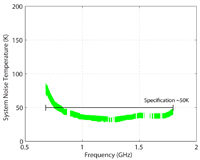ASKAP PAF receivers achieve performance goal16 December 2013 Successful results have been achieved by CSIRO in tests of its revolutionary new Phased Array Feed (PAF) receiver technology designed for radio astronomy. Results confirm that the MkII generation PAF system design will reach performance targets. Using a proof-of-concept scale PAF receiver system, the team demonstrated excellent performance in the aperture array mode test of system noise temperature, close to 50K across the entire ASKAP frequency band (0.7–1.8 GHz). CSIRO has developed these cutting-edge receivers (also known as 'radio cameras') for its newest telescope, the Australian SKA Pathfinder (ASKAP), and for the future international SKA radio telescope project. Six first generation (MkI) PAF systems have already been installed on ASKAP antennas at the Murchison Radio-astronomy Observatory (MRO) in Western Australia. Development of the MkII receiver chain for ASKAP has been underway through a design optimisation program called ASKAP Design Enhancements (ADE), aimed at developing a second generation receiver that offers significant benefits in system performance. The ADE program has focused on cost-effective technologies to increase efficiency and digital processing flexibility, while reduce manufacturing complexity, leading to reductions in overall cost and build time. Aperture array tests were performed on a 40 element PAF system, including ADE-style tiled chequerboard, front end assembly and LNAs, using a ground-based test facility at CSIRO's Parkes Observatory. The team achieved system temperature measurements with the 40 element array that are near optimal for the current generation of electronics. The full-size ADE PAF, made up of 188 elements, when installed on an ASKAP antenna at the MRO will perform somewhat better at the lower end of the frequency range. "We are making great strides in the development of phased array feeds," said Lewis Ball, Chief of CSIRO Astronomy and Space Science, "Test results from the ADE PAF are a significant step towards meeting the cost/performance demands of ASKAP and the SKA, and the technology will be a game changer for radio astronomy in general." The successful verification results will now lead into the production of full sized ADE PAFs, with deployment to the MRO expected in 2014. Back to Latest ASKAP News page. |
This loads a font easier to read for people with dyslexia.
This renders the document in high contrast mode.
This renders the document as white on black
This can help those with trouble processing rapid screen movements.

